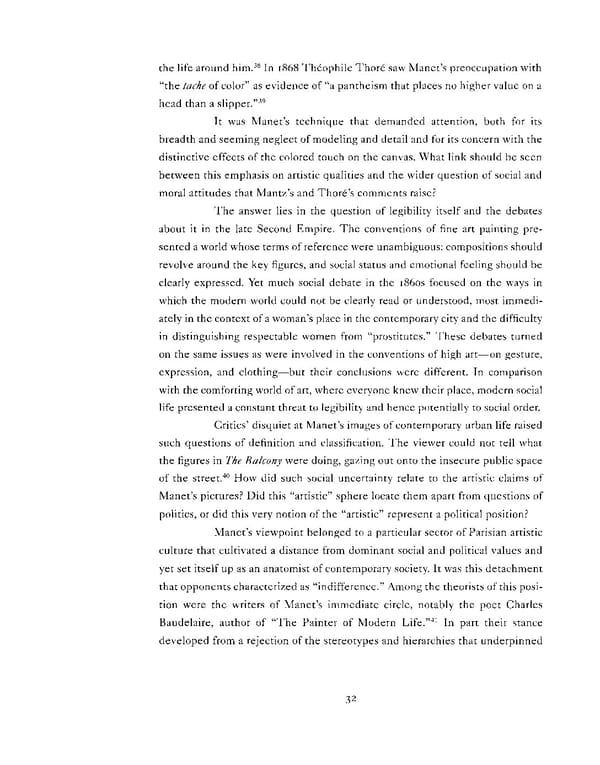38 the life around him. In 1868 Theophile Thore saw Manet's preoccupation with "the tache of color" as evidence of "a pantheism that places no higher value on a 39 head than a slipper." It was Manet's technique that demanded attention, both for its breadth and seeming neglect of modeling and detail and for its concern with the distinctive effects of the colored touch on the canvas. What link should be seen between this emphasis on artistic qualities and the wider question of social and moral attitudes that Mantz's and Thore's comments raise? The answer lies in the question of legibility itself and the debates about it in the late Second Empire. The conventions of fine art painting pre- sented a world whose terms of reference were unambiguous: compositions should revolve around the key figures, and social status and emotional feeling should be clearly expressed. Yet much social debate in the i86os focused on the ways in which the modern world could not be clearly read or understood, most immedi- ately in the context of a woman's place in the contemporary city and the difficulty in distinguishing respectable women from "prostitutes." These debates turned on the same issues as were involved in the conventions of high art—on gesture, expression, and clothing—but their conclusions were different. In comparison with the comforting world of art, where everyone knew their place, modern social life presented a constant threat to legibility and hence potentially to social order. Critics' disquiet at Manet's images of contemporary urban life raised such questions of definition and classification. The viewer could not tell what the figures in The Balcony were doing, gazing out onto the insecure public space 40 of the street. How did such social uncertainty relate to the artistic claims of Manet's pictures? Did this "artistic" sphere locate them apart from questions of politics, or did this very notion of the "artistic" represent a political position? Manet's viewpoint belonged to a particular sector of Parisian artistic culture that cultivated a distance from dominant social and political values and yet set itself up as an anatomist of contemporary society. It was this detachment that opponents characterized as "indifference." Among the theorists of this posi- tion were the writers of Manet's immediate circle, notably the poet Charles 41 Baudelaire, author of "The Painter of Modern Life." In part their stance developed from a rejection of the stereotypes and hierarchies that underpinned 32
 Pierre-Auguste Renoir: La Promenade Page 39 Page 41
Pierre-Auguste Renoir: La Promenade Page 39 Page 41